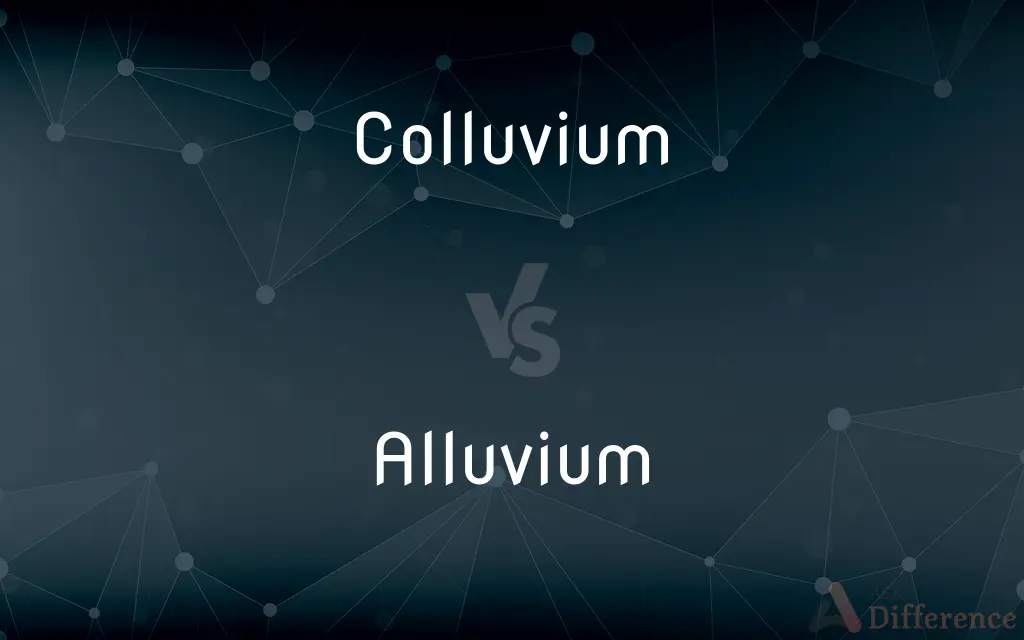Colluvium vs. Alluvium — What's the Difference?
By Tayyaba Rehman & Maham Liaqat — Updated on March 22, 2024
Colluvium is loose material deposited by gravity, while alluvium is sediment deposited by flowing water.

Difference Between Colluvium and Alluvium
Table of Contents
ADVERTISEMENT
Key Differences
Colluvium refers to the loose, unconsolidated soil or debris that accumulates at the base of a slope or cliff, primarily due to gravitational pull. It often results from processes like soil creep, landslides, or direct wash-off from rainfall. Alluvium, on the other hand, consists of sediment that is deposited by flowing water, particularly in rivers, floodplains, and deltas. This material can range from silt to gravel and is typically more sorted and stratified compared to colluvium due to the sorting action of water.
The origin of colluvium is predominantly gravitational, meaning it collects directly where it falls or slides down a slope, leading to a heterogeneous mixture of material sizes and types. Alluvium's formation involves transportation by water, which tends to sort the particles by size and weight, resulting in more uniform deposits. The processes behind these deposits underscore the distinct dynamics of gravity versus water flow in shaping the landscape.
Colluvium deposits are often found in areas with significant elevation changes and can indicate past or potential instability in slopes. Alluvium, however, is commonly associated with river valleys and floodplains where water has the energy to carry sediments over distances before depositing them in new locations. The environments where colluvium and alluvium are found reflect the contrasting forces of their formation and the diverse landscapes they help create.
In terms of fertility, alluvium is generally more fertile than colluvium due to its finer particles and the presence of organic matter transported by water. This makes alluvial soils highly sought after for agriculture. Colluvium may also support vegetation but is typically less uniform and may contain a higher proportion of larger fragments, making it less ideal for farming but suitable for certain types of vegetation adapted to these conditions.
Despite their differences, both colluvium and alluvium play significant roles in the natural buildup and shaping of landscapes. They provide valuable records of past environmental conditions and processes, offering insights into the history of landform development and the forces at work in different settings.
ADVERTISEMENT
Comparison Chart
Formation Process
Gravity-induced accumulation at slopes' bases.
Water-transported sediments deposited in rivers, floodplains.
Particle Sorting
Poorly sorted, heterogeneous.
Well sorted, stratified by size due to water flow.
Typical Location
At the base of slopes, cliffs.
Along rivers, in floodplains and deltas.
Material Composition
Mixed sizes, from silt to boulders.
Varied, but more uniformly sized, from clay to gravel.
Fertility
Less fertile, supports certain vegetation.
Highly fertile, ideal for agriculture.
Compare with Definitions
Colluvium
Formed by gravitational pull.
Heavy rainfall triggered the colluvium deposit.
Alluvium
Sediment deposited by flowing water.
The fertile farm land was located on alluvium.
Colluvium
Accumulation of debris at the base of slopes.
The garden was built on a thick layer of colluvium.
Alluvium
Ideal for agriculture.
The ancient civilizations thrived on the alluvial plains.
Colluvium
Supports diverse vegetation.
The colluvium-rich slope was covered with shrubs and trees.
Alluvium
Reflects water's transporting ability.
The spread of alluvium downstream indicated the river's historical path.
Colluvium
Contains mixed material sizes.
The colluvium layer consisted of both soil and large rocks.
Alluvium
Found in riverbeds and floodplains.
The alluvium in the delta region was especially nutrient-rich.
Colluvium
Indicates slope instability.
Colluvium deposits suggested past landslides in the area.
Alluvium
Well-sorted material.
The river's alluvium was composed mainly of fine sands and silt.
Colluvium
Colluvium (also colluvial material or colluvial soil) is a general name for loose, unconsolidated sediments that have been deposited at the base of hillslopes by either rainwash, sheetwash, slow continuous downslope creep, or a variable combination of these processes. Colluvium is typically composed of a heterogeneous range of rock types and sediments ranging from silt to rock fragments of various sizes.
Alluvium
Alluvium (from the Latin alluvius, from alluere, "to wash against") is loose clay, silt, sand, or gravel that has been deposited by running water in a stream bed, on a floodplain, in an alluvial fan, or in similar settings. Alluvium is also sometimes called alluvial deposit.
Colluvium
A loose deposit of rock debris accumulated through the action of gravity at the base of a cliff or slope.
Alluvium
Sediment deposited by flowing water, as in a riverbed, flood plain, or delta. Also called alluvion.
Colluvium
(geology) A loose accumulation of rock and soil debris at the foot of a slope
Alluvium
Soil, clay, silt or gravel deposited by flowing water, as it slows, in a river bed, delta, estuary or flood plain
Alluvium
Deposits of earth, sand, gravel, and other transported matter, made by rivers, floods, or other causes, upon land not permanently submerged beneath the waters of lakes or seas.
Alluvium
Clay or silt or gravel carried by rushing streams and deposited where the stream slows down
Common Curiosities
What are the differences in particle size between colluvium and alluvium?
Colluvium typically has a mix of particle sizes due to direct gravitational drop, while alluvium has more uniformly sized particles, sorted by water.
Can alluvium only be found near water?
Primarily, yes, alluvium is found in areas influenced by water, like riverbeds and floodplains, but it can also be found in ancient, dried-up waterways.
What defines colluvium?
Colluvium is defined by its accumulation at the base of slopes, primarily due to gravity, including soil, rock fragments, and organic material.
Can colluvium indicate geological history?
Yes, the presence of colluvium can indicate past geological events like landslides or soil erosion, offering clues about the area’s stability.
Are colluvium and alluvium renewable resources?
They can be considered renewable in geological terms through ongoing natural processes, but human-induced changes can affect their renewal rates.
Are there specific plants that thrive on colluvium?
Yes, certain plants and trees are well adapted to the varied and less fertile conditions of colluvium compared to the more fertile alluvial soils.
How is alluvium formed?
Alluvium is formed by the deposition of sediment by flowing water, such as rivers and streams, often resulting in fertile soils.
How can you distinguish between colluvium and alluvium?
Colluvium is often found at the base of slopes with a mix of particle sizes, while alluvium is typically well-sorted, found in water-influenced locations.
Why is alluvium considered fertile?
Alluvium is considered fertile due to its fine particles, good water retention, and often rich organic content, making it excellent for farming.
Is alluvial soil good for all types of crops?
Alluvial soil is generally fertile and suitable for a wide range of crops, but specific crop suitability can depend on soil depth, texture, and mineral content.
Does the age of colluvium and alluvium deposits matter?
Yes, the age can indicate the timeline of geological or hydrological events, affecting the soil’s characteristics and suitability for different uses.
What role does vegetation play in colluvium deposits?
Vegetation can help stabilize colluvium deposits, reducing the risk of soil erosion and landslides by anchoring the soil.
How do colluvium and alluvium affect land use?
The presence of alluvium often indicates good agricultural potential, while colluvium can affect land stability, impacting construction and land management.
Can colluvium deposits lead to natural hazards?
Yes, large accumulations of colluvium on unstable slopes can lead to landslides, especially after heavy rainfall or seismic activity.
How do humans impact colluvium and alluvium?
Human activities like construction, agriculture, and river management can alter the distribution, composition, and stability of colluvium and alluvium deposits.
Share Your Discovery

Previous Comparison
Barkeep vs. Bartender
Next Comparison
Hustle vs. HustlerAuthor Spotlight
Written by
Tayyaba RehmanTayyaba Rehman is a distinguished writer, currently serving as a primary contributor to askdifference.com. As a researcher in semantics and etymology, Tayyaba's passion for the complexity of languages and their distinctions has found a perfect home on the platform. Tayyaba delves into the intricacies of language, distinguishing between commonly confused words and phrases, thereby providing clarity for readers worldwide.
Co-written by
Maham Liaqat













































